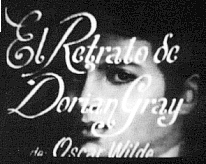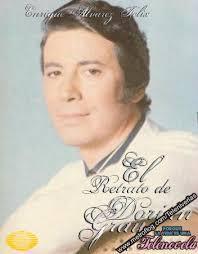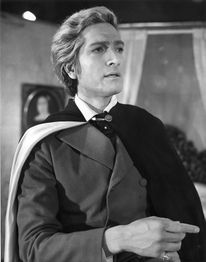El Retrato de Dorian Gray (lost Mexican TV drama based on Oscar Wilde novel; 1969): Difference between revisions
(Rewrote part of the opening paragraph to focus on the article's subject rather than the original work.) |
No edit summary |
||
| (2 intermediate revisions by 2 users not shown) | |||
| Line 2: | Line 2: | ||
|title=<center>El retrato de Dorian Gray (The Picture of Dorian Gray)</center> | |title=<center>El retrato de Dorian Gray (The Picture of Dorian Gray)</center> | ||
|image=El_retrato_de_Dorian.jpg | |image=El_retrato_de_Dorian.jpg | ||
|imagecaption=Possibly the title card | |imagecaption=Possibly the title card, featuring a picture of the main character. | ||
|status=<span style="color:red;">'''Lost'''</span> | |status=<span style="color:red;">'''Lost'''</span> | ||
}} | }} | ||
'''''El Retrato de Dorian Gray''''' is a Mexican TV drama based on the novel of the same name by Irish author Oscar Wilde. Produced by Enrique Alonso and broadcasted on channel 4 (now channel 2, "Las Estrellas") by Telesistema Mexicano (now known as Televisa Mexico) in 1969, it was never reaired after its original run, leading to its obscurity and lack of publicly available footage. | |||
==Original Work== | ==Original Work== | ||
In 1890, Irish author Oscar Wilde published an early version of his novel | In 1890, Irish author Oscar Wilde published an early version of his novel ''The Picture of Dorian Gray'' for the first time on ''Lippincott's Monthly Magazine'', and a final revised version was published by Ward Lock & Co in 1891. The novel itself was an object of controversy due to its homoerotic subtext and strong social commentary, with critics calling it "mawkish and nauseous, unclean, effeminate and contaminating". | ||
Despite the controversy, ''The Picture of Dorian Gray'' became a literary classic due to its criticism and treatment of the time's bourgeois society, its shallowness and immorality. | |||
==Plot== | ==Plot== | ||
The plot of ''El Retrato de Dorian Gray'' is presumably the same as the original novel | The plot of ''El Retrato de Dorian Gray'' is presumably the same as the original novel's: Dorian Gray, a naive and young gentleman that becomes the favorite model of Basil Hallward, a painter who is fascinated with Dorian's youth and beauty. They soon meet Lord Henry Wotton, a close friend of Basil's, who preaches to Dorian that beauty is the only aspect of life worth pursuing. This makes Dorian wish he would sell his soul to never grow old, and that only his portrait would age; his wish is granted, and while Dorian lives out a debauched, hedonistic lifestyle, his portrait ages and decays, recording all of his sins. | ||
==Cast/Development== | ==Cast/Development== | ||
The cast of ''El Retrato de Dorian Gray'' | The cast of ''El Retrato de Dorian Gray'' featured actors of its time, such as Enrique Alvarez Felix, son of actress Maria Felix, as Dorian Gray,<ref>[https://web.archive.org/web/20140109210135/http://www.seriesnow.com/latinamerican-actors/enrique-alvarez-felix.html Archived page listing all of Enrique Alvarez Felix's leading roles.] Retrieved 23 Nov '18</ref> Carlos Bracho as Lord Henry Wotton, Carmen Montejo as Lady Wotton, and Silvia Pasquel as Sybil Vane. | ||
Although | Although biographies of Enrique Alvarez Felix mention this show, Televisa's official website and other official media have no records of it. Some fansites have scavenged information on this show, with little cast information being available. Only an IMDB page says anything about the cast, and only one still of Carlos Bracho as Lord Henry has been found. | ||
IMDB claims that the show was recorded in black and white; the Spanish Wikipedia page for the show claims that this was Televisa's first drama broadcast in color, but also mentions that the recordings were in B/W. Only three episodes were produced or filmed, but the plot in each one is unknown. | |||
==Availability== | ==Availability== | ||
This show has never been reaired or made available on Televisa's official streaming network Blim or even in bootleg recordings. It has never been released on home video, and given Televisa's silence about it, it might never be re-released. It is believed that this happened because Televisa, in the 1980s, announced a ban on all homosexual actors and actresses. | |||
It is believed that this happened because in the 1980s, | |||
==Gallery== | ==Gallery== | ||
| Line 43: | Line 38: | ||
[[Category:Lost TV|Retrato de Dorian Gray]] | [[Category:Lost TV|Retrato de Dorian Gray]] | ||
Revision as of 11:47, 13 January 2019
El Retrato de Dorian Gray is a Mexican TV drama based on the novel of the same name by Irish author Oscar Wilde. Produced by Enrique Alonso and broadcasted on channel 4 (now channel 2, "Las Estrellas") by Telesistema Mexicano (now known as Televisa Mexico) in 1969, it was never reaired after its original run, leading to its obscurity and lack of publicly available footage.
Original Work
In 1890, Irish author Oscar Wilde published an early version of his novel The Picture of Dorian Gray for the first time on Lippincott's Monthly Magazine, and a final revised version was published by Ward Lock & Co in 1891. The novel itself was an object of controversy due to its homoerotic subtext and strong social commentary, with critics calling it "mawkish and nauseous, unclean, effeminate and contaminating".
Despite the controversy, The Picture of Dorian Gray became a literary classic due to its criticism and treatment of the time's bourgeois society, its shallowness and immorality.
Plot
The plot of El Retrato de Dorian Gray is presumably the same as the original novel's: Dorian Gray, a naive and young gentleman that becomes the favorite model of Basil Hallward, a painter who is fascinated with Dorian's youth and beauty. They soon meet Lord Henry Wotton, a close friend of Basil's, who preaches to Dorian that beauty is the only aspect of life worth pursuing. This makes Dorian wish he would sell his soul to never grow old, and that only his portrait would age; his wish is granted, and while Dorian lives out a debauched, hedonistic lifestyle, his portrait ages and decays, recording all of his sins.
Cast/Development
The cast of El Retrato de Dorian Gray featured actors of its time, such as Enrique Alvarez Felix, son of actress Maria Felix, as Dorian Gray,[1] Carlos Bracho as Lord Henry Wotton, Carmen Montejo as Lady Wotton, and Silvia Pasquel as Sybil Vane.
Although biographies of Enrique Alvarez Felix mention this show, Televisa's official website and other official media have no records of it. Some fansites have scavenged information on this show, with little cast information being available. Only an IMDB page says anything about the cast, and only one still of Carlos Bracho as Lord Henry has been found.
IMDB claims that the show was recorded in black and white; the Spanish Wikipedia page for the show claims that this was Televisa's first drama broadcast in color, but also mentions that the recordings were in B/W. Only three episodes were produced or filmed, but the plot in each one is unknown.
Availability
This show has never been reaired or made available on Televisa's official streaming network Blim or even in bootleg recordings. It has never been released on home video, and given Televisa's silence about it, it might never be re-released. It is believed that this happened because Televisa, in the 1980s, announced a ban on all homosexual actors and actresses.
Gallery
External Links
- IMDb page about the show. Retrieved 23 Nov '18
- A Spanish Wikipedia article about the show. Retrieved 23 Nov '18
Reference
- ↑ Archived page listing all of Enrique Alvarez Felix's leading roles. Retrieved 23 Nov '18


